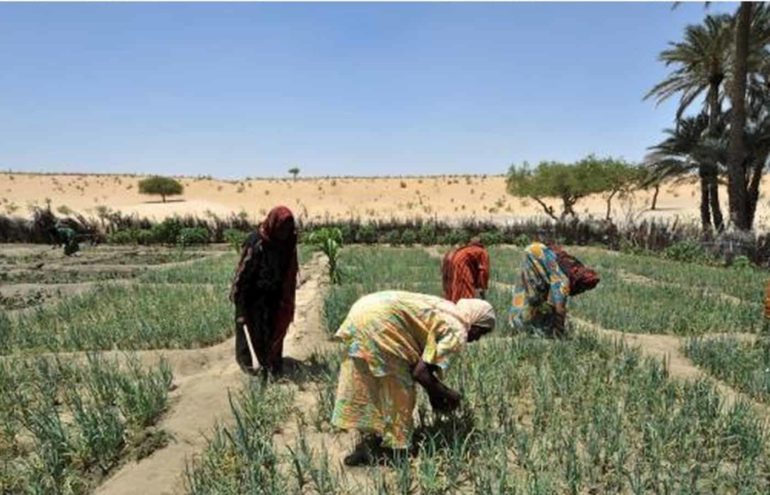In Africa, agriculture supports the livelihoods of over 800 million people (80 percent of the population), providing employment for around 60 percent of the economically active population and 70 percent of the poorest (around 270 million people).
Smallholder farmers, pastoralists and agro-pastoralists living in drylands and relying on crops, livestock, fisheries, and forests for their livelihoods are often the worst affected when a disaster strikes. However, in Africa, it is not only about the level of exposure to disaster risks, but the capacity to prevent, anticipate, manage and recover from disasters and crises.
Africa accounts for only 15 percent of global natural disasters, however, the toll of these disasters is quite severe in terms of human development set-backs. Strengthening vulnerable people to become resilient to threats and crises is a priority for human development in this region.
This is why FAO started its Resilience Initiative in Africa’s Drylands in 2012. Nine focus countries were identified to benefit from a proactive support to improve their capacities at both national and community levels in the Sahel (Burkina Faso, Chad, Mali, and Niger), the Horn of Africa (Ethiopia, Kenya, Somalia, South Sudan) and Southern Africa (Zimbabwe).
This initiative builds on existing experience and involves strong collaboration with similar initiatives and partnerships in the region, such as the Global Alliance for Resilience Initiative (AGIR) in the Sahel and the Supporting Horn of Africa Resilience (SHARE) initiatives.
The FAO Regional Initiative assists countries to strengthen institutional capacity for developing and implementing policies on risk prevention and reduction including focus on Regional Economic Communities (RECs) and other regional bodies. It also facilitates knowledge exchange across sub-regions and between countries.
Furthermore, it aims at supporting partners in learning and applying vulnerability mapping and analysis through already existing tools such as Integrated Food Security Phase Classification (IPC), Resilience Index Measurement and Analysis (RIMA) as well as improving and extending early warning systems.
Anticipating and preventing recurrent crises affecting food security and nutrition proactively is critical to address the root causes of the vulnerability of farmers, herders and fishermen, particularly women. This is particularly true if we consider that these drylands with their fragile ecosystems are facing a recurrent combination of natural disasters, food chain crises, conflicts and protracted crises.
Examples of some of FAO successful programmes and activities in resilience building of vulnerable people in Chad, Kenya and Zimbabwe are presented below.
In recent years, Chad experienced frequent food crises, mainly caused by droughts. Rural communities, particularly women, play a key role in the fight against the root causes of vulnerability in rural areas. In 2010, FAO initiated a market gardening project targeting single mothers with malnourished children. Women were introduced to market gardening to improve their families’ diet and nutritional status. Surplus vegetable produce was sold for income, enabling beneficiaries to purchase other foodstuffs, especially cereals, to meet their daily food needs. The project also benefited the wider community, as it contributed to the increased market availability of affordable, locally grown vegetables. In spite of the threat of drought, these women continue to cultivate the land, and are a crucial pillar in their households and the community at large.
Kenya, in the last decade, faced about five serious food and nutrition crises owing to droughts, with a residual half a million to a million people dependent on food assistance even in non-drought years. The government of Kenya has been addressing the issue of reducing vulnerability, risks and impacts of crises through sustainable development and resilience building.
In 2012, FAO helped the Government with the construction of 124 km of irrigation canals along the Turkwel River in the semi-arid region of Turkana. The development of small-scale irrigation schemes has doubled the area of cultivated land under irrigation in the area. Local farmers buy into the schemes, either individually or in small groups, purchasing low-cost equipment such as buckets, watering cans and pumps for distribution. Such small-scale irrigation has contributed significantly to poverty alleviation, food security and livelihoods in the region while also improving environmental conservation.
FAO is also assisting the Ministry of Agriculture, Forestry and Fisheries in Kenya in the implementation of climate-smart initiatives. Climate-smart agriculture entails identifying and applying the most appropriate activities for responding to specific climatic challenges in a given location. Climate-smart projects have been carried out in the counties of Nakuru, Bungoma, Laikipia, Machakos, Embu and Siaya, where FAO has been working with over 3 000 households to formulate and implement a set of adaptation measures. Successful implementation of the recommended practices has enabled farmers to double their productivity levels.
In 2015, a large number of Zimbabweans, especially in the southern parts of the country, have been facing food security crisis largely as a result of drought and scarce rains. To cope adequately with the cause of food insecurity in Zimbabwe, the Livelihoods and Food Security Programme and other programmes are moving from a reactive response to a proactive and prevention-focused response with a particular focus on community level actions to strengthen resilience. In particular, FAO is supporting Zimbabwe’s recovery by promoting appropriate climate – smart agricultural practices and technologies – such as greater crop diversity, improved storage, processing and preservation, crop rotations, conservation agriculture and irrigation; facilitating greater access to markets and monitoring the food security situation. As a result, it increases farm productivity and incomes, and makes agriculture more resilient to climate change.
Resilience building demands multi-hazard, multi-disciplinary and multi-actor partnership initiatives. Collaboration among all partners is important to ensure that services to vulnerable institutions and populations are provided and that these services are preventive and risk-sensitive.







